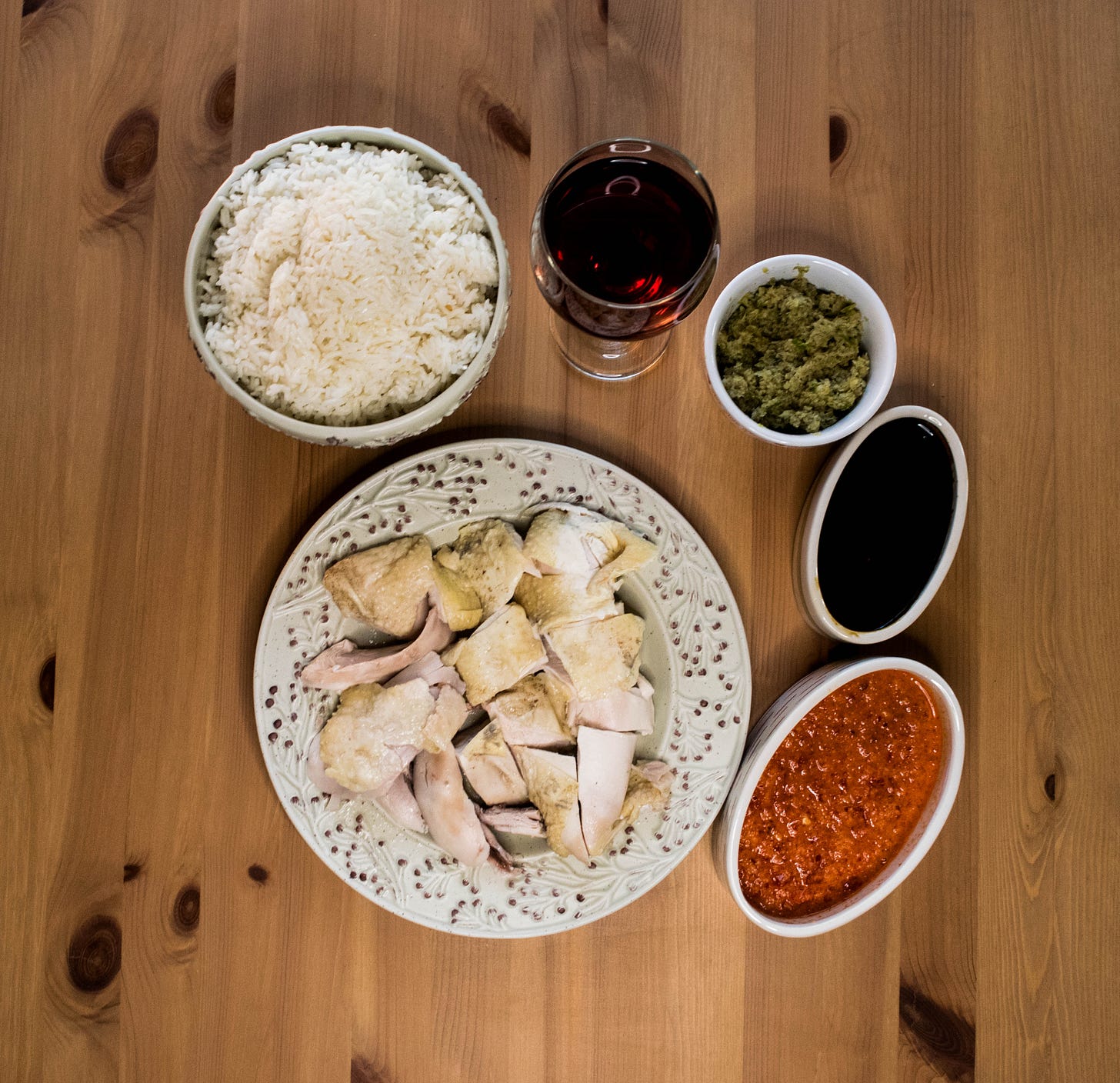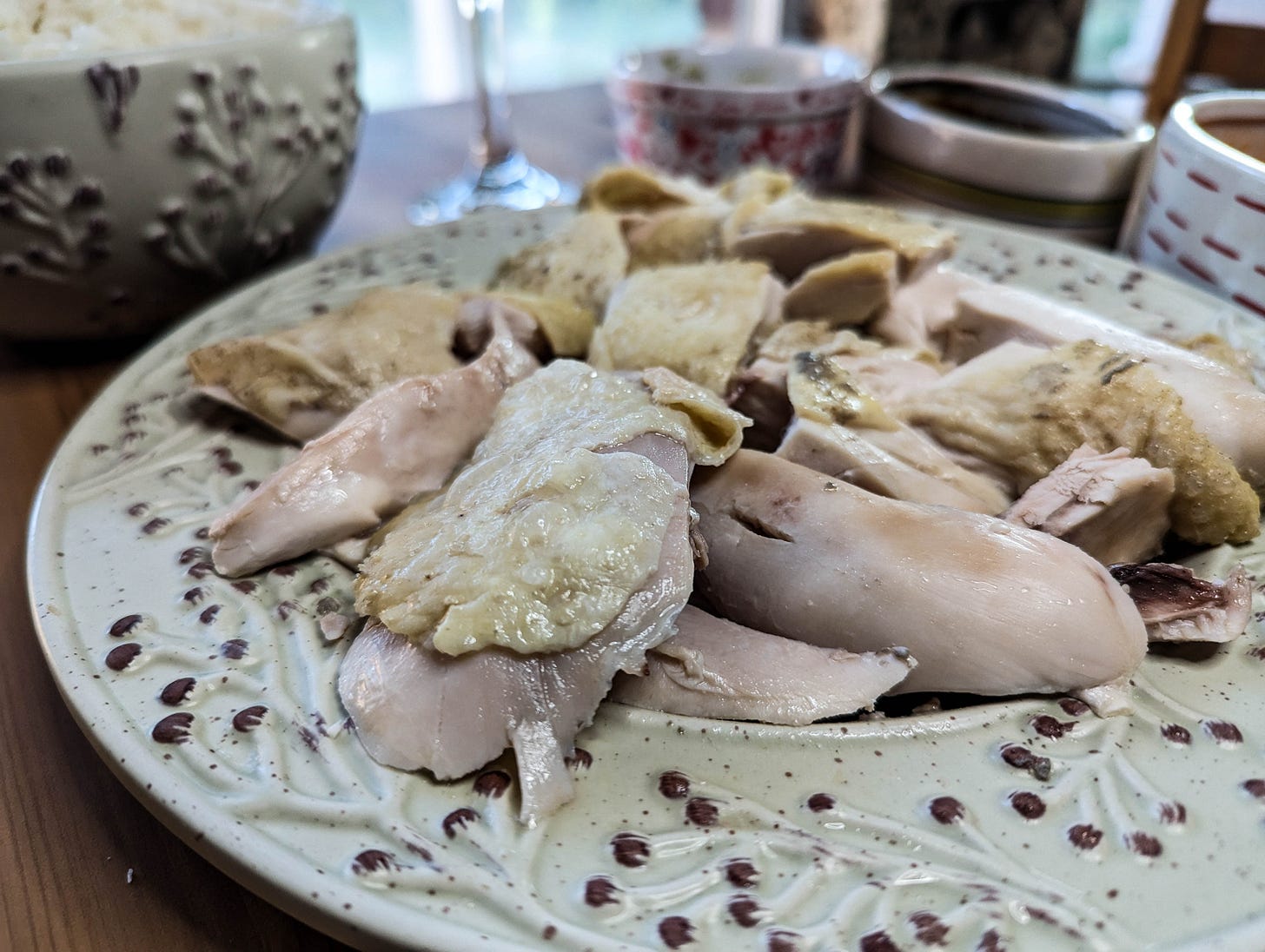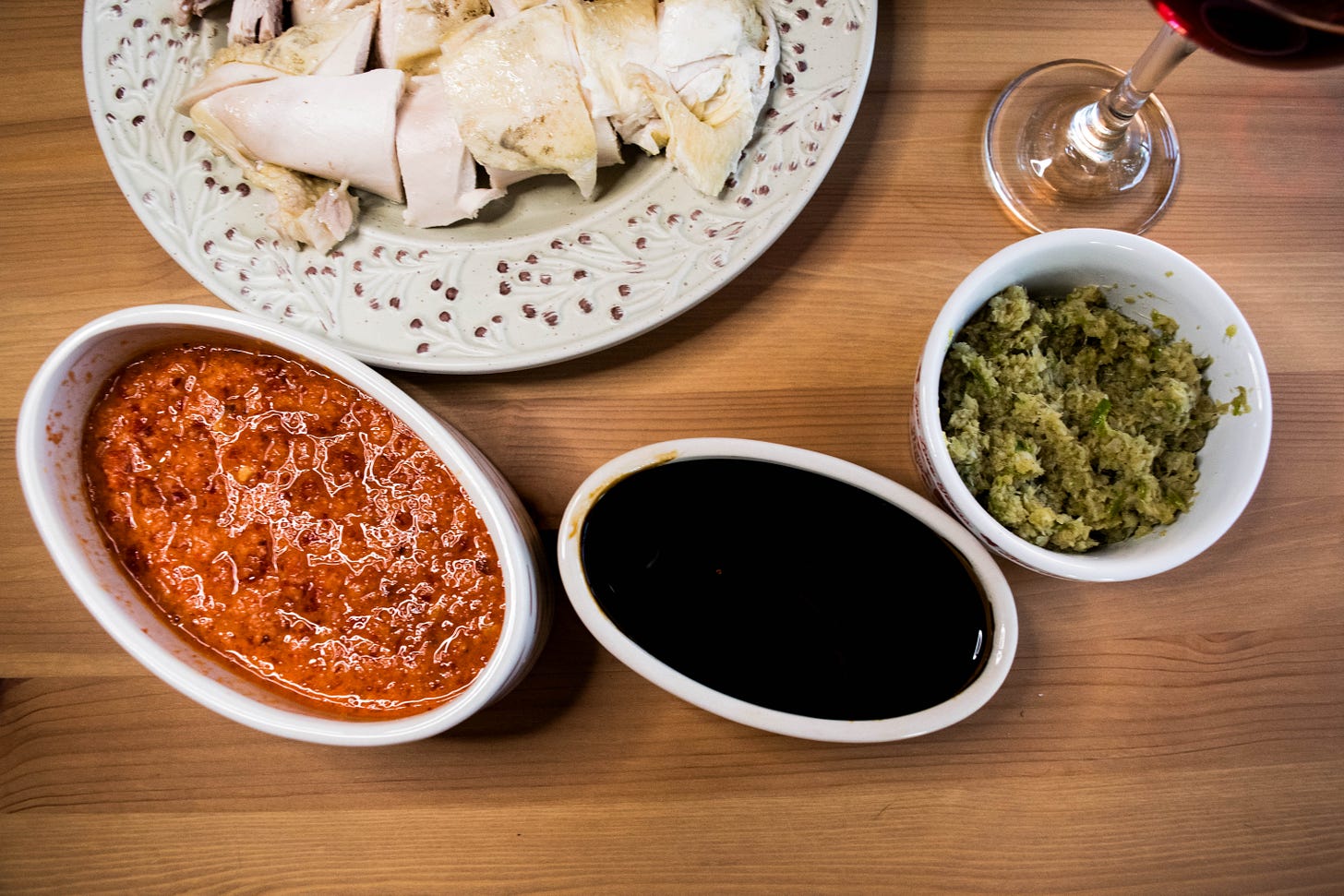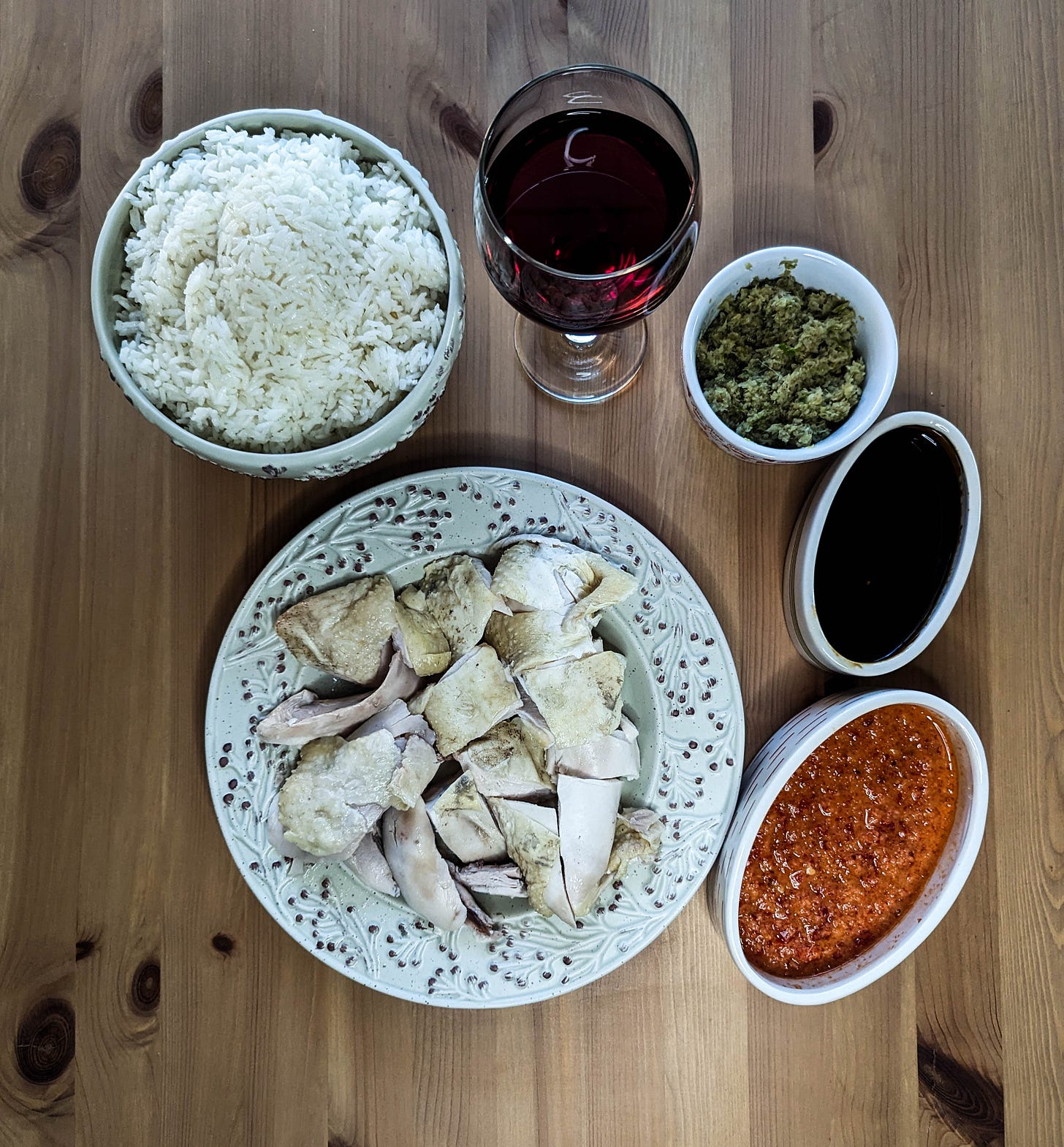Singapore Grand Prix: Cooking Hainanese Chicken Rice
Welcome to Grand Prix Gastronomy! This week, I’m cooking Hainanese chicken rice, which Singapore recognizes as its national dish.
This project is pretty simple. As a complement to each race weekend, I’ll be cooking the national dish of that race’s host country and sharing information about the process and that dish’s history along the way in an effort to grow more deeply immersed in the local culture from my own home.
Thanks for reading Grand Prix Gastronomy! Subscribe for free to receive new posts and support my work.
What Is Hainanese Chicken Rice?
According to International Cuisine, Singapore’s national dish is a little something called Hainanese chicken rice. Here, you poach a whole chicken and then quickly stop its cooking by dousing it in an ice bath, then use that tasty poaching liquid to cook the rice. I can’t say that the chicken’s purported “gelatinous" texture sounded super appealing, but I was willing to ignore that — if only because this dish is served with three different sauces, all of which sound great. (Other food bloggers have used the words “silky" and “moist" to describe the chicken, which I have to say is a lot more appetizing.)
As the name suggests, this dish doesn’t actually originate in Singapore; instead, it comes from the Hainan Island region of China, which is the smallest and southernmost province of the country. The tropical climate means it’s a great rice-growing region, but the Hainan Province is known for being lighter, less oily, and more mildly seasoned than what you’d find in mainland China. In Hainan, the dish is actually called Wenchang chicken.
The reason Hainanese chicken rice has become so popular elsewhere came thanks to a mass migration from Hainan to Singapore — a migration that inevitably came with a set of culinary trends adapted to fit the new region, where immigrants tried to make something as simple as chicken last as long as possible and become as flavorful as possible. Because of that migration, you’ll also find variations of this dish in other countries in several different Southeast Asian countries, including Malaysia and Thailand.
This Week's Recipe
I picked a recipe from one of my absolute favorite food blogs, The Woks of Life —largely because I’ve actually had this exact recipe in my immense bookmarks tab for ages but never made it because I knew it required a little elbow grease that I usually don’t use in a weekday dinner.
I love The Woks of Life, not just for the delicious recipes, but for its history lesson and detailed preparation instructions. If you’re looking to create authentic Asian cuisines, this is a great place to start because you’re pretty much guaranteed a comprehensive set of instructions that’ll help your recipe turn out perfectly every single time.
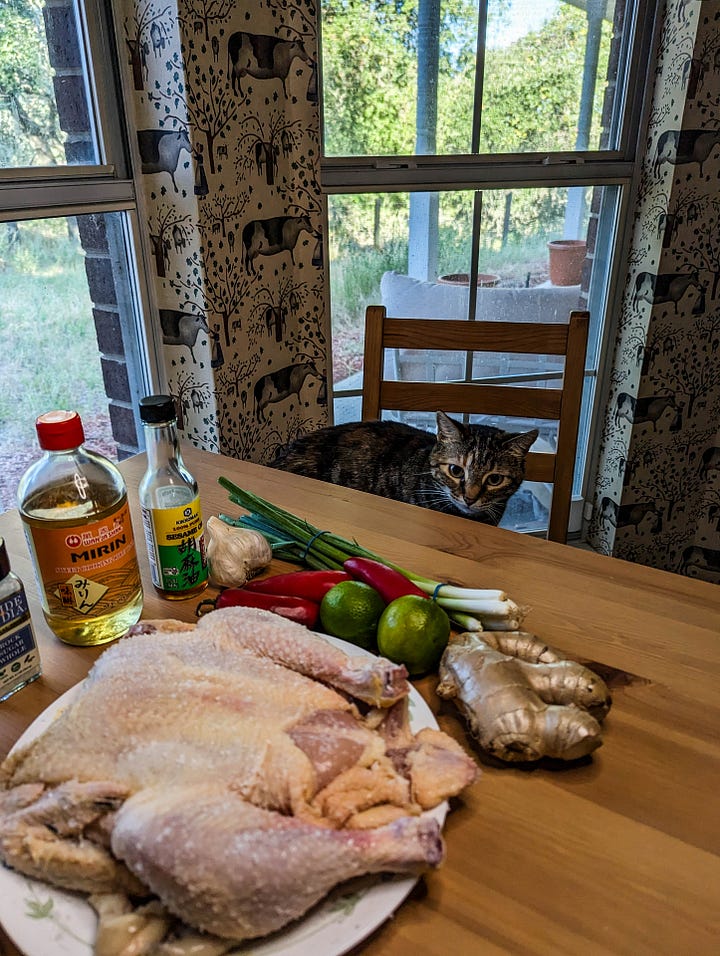
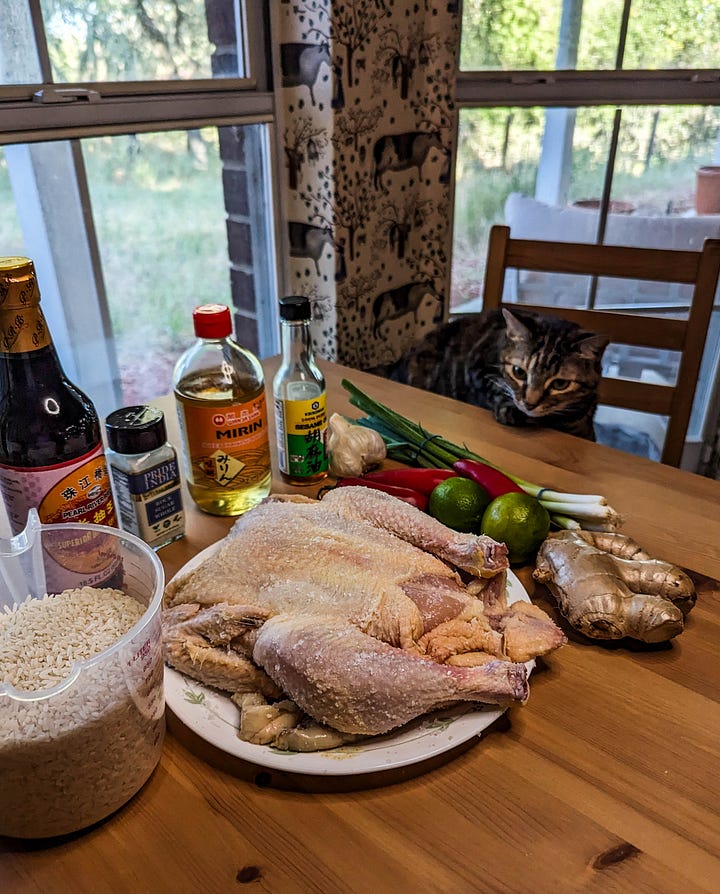
The three sauces here also looked like they were to die for. They’re all traditional of the dish, but the photos here sold me. I highly recommend making all three sauces, even though it might seem like overkill. The ginger-garlic oil is deeply aromatic, a punch of flavor that doesn’t overwhelm you. The sweet dark soy sauce is thick, sticky, and delicious; it’s kind of teriyaki-y. Finally, there’s the chili sauce. The chili sauce is to die for. If you do a little mixing and matching with the sauces, well — I definitely can’t blame you, and I highly recommend it.
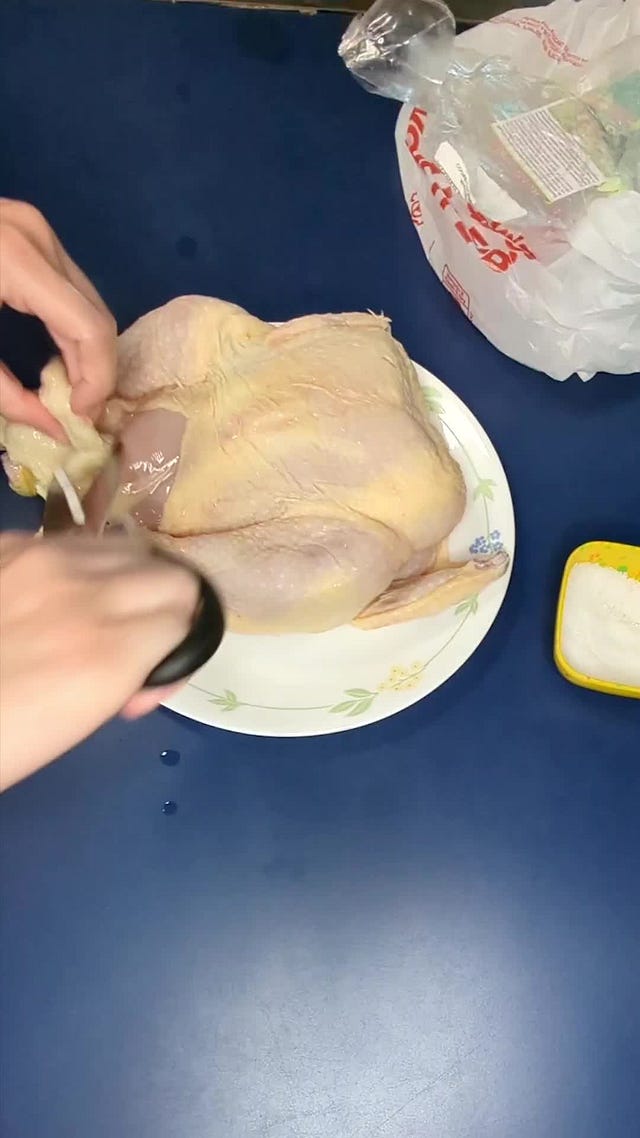
 Tiktok failed to load.
Tiktok failed to load.Enable 3rd party cookies or use another browser
Cooking Hainanese Chicken Rice
To kick off this dish, I started by prepping a whole chicken, which in this case means giving it a good rinse, patting it dry, and then rubbing it with plenty of salt to both exfoliate and flavor the chicken. You want to let that salt sit on the meat for up to 24 hours — the longer the better, since this is primarily what's going to flavor your meat.
After that, I actually moved on to making my sauces! Hainanese chicken rice is served with three different side sauces, all of which were pretty easy to put together. The first, a ginger-garlic sauce, just required some ginger and garlic to be ground up in a food processor, then cooked in some oil with salt until the raw flavor disappeared. For the chili sauce, you just add ginger, fresh red chilies, garlic, sesame oil, salt, sugar, lime juice, rice vinegar, and chicken broth to a food processor, blending until it's a nice fine paste. Finally, for the sweet dark soy sauce, let some water and rock salt simmer on the stove until it's reduced to a syrup, then stir in the dark soy sauce. Easy! (You can use regular soy sauce for this, but dark soy sauce has a much greater depth of flavor.)
Next up is the chicken itself. After you've let the meat rest in its salt scrub, bring a pot of water to a boil with some scallions and ginger slices. When it starts rolling, add the chicken and bring to a boil again. Then, dump out the cold juices inside the chicken cavity, return the chicken to the pot, and — you guessed it — bring it to a boil one more time. Once you have it there, cover the pot, and then either turn off the heat, or leave it on a very, very low setting. (As my chicken was larger than the recipe called for, I opted for a low heat to poach the chicken.)
After you've poached the meat, prep an ice bath, then dunk your chicken in it right from the pot. The ice bath will stop any lingering cooking processes and also help give the meat a more gelatinous texture.
As the chicken cools, you'll make some rice. Rend chicken fat in a pan, then fry up some garlic. If you don't have a rice cooker, I recommend rinsing and soaking your rice for at least 20 minutes before adding it to your wok and letting it fry just a bit. Then, pour it into a pot with some of your chicken poaching liquid and let it cook until finished. Carve up the meat and serve it family style.
I served my meal with a gently chilled cinsault wine, which is a light red with low tannins that can pair well with pretty much anything.
So, What's the Verdict?
I try to keep an open mind with everything Grand Prix Gastronomy, but I'll be real with y’all: the concept of “gelatinous” cooled chicken has never necessarily crossed my mind as a to-die-for dish. It reminded me a lot of a particular scene in the Dick Seaman (yes that is a real name) biography A Race with Love and Death, where Dick & Co. feast on an “iced chicken soup,” something that I've pegged as an egregious culinary sin and duly made fun of since I first read the tale. I also was very aware of the fact that I'm coming from a place of immense Western bias; I'm totally cool with eating most leftovers straight from the fridge, but present that as an Eastern dish, and somehow I'm no longer fine with it?
For all my skepticism, I have to say that this dish was frickin’ delightful. By the time I'd carved up my chicken and sat down to dinner, it was still a little warm despite its ice bath, and it was perfectly moist. I do think I was missing out on a little bit of flavor from the poaching broth, but in reading more recipes, I think I'd have benefitted from a couple things: salting the chicken 24 hours in advance, infusing the poaching liquid with aromatics for a longer time, and stuffing the chicken cavity with said aromatics. Then, I think I'd have a real winner.
But it is key to remember that the flavor from this dish is primarily coming from your sauces, which are incredible! I'm A Big Sauce Guy — honestly, the more sauce the better — so having three dips for my chicken and rice was divine. The ginger-garlic was fantastic for a more aromatic kind of flavor, while the sweet dark soy sauce was thick and cloying in a way that was actually really appealing. My favorite, though, was the chili sauce; I put sweet chili sauce on just about every food known to man, and this was basically just a more savory version. I ended up using it as a dipping sauce for some crispy smashed potatoes I made for a family dinner the following day.
And the rice! While you're not going to be punched in the face with flavor, the combination of frying your garlic in rendered chicken fat and then cooking the rice itself in the chicken poaching liquid gave the whole thing a nice umami taste that transcended plain ol’ white rice. This is easily going to be my go-to rice recipe from now on.
I was so pleased with the whole dish, but it's probably not one of the ones I'd cook in full again — mostly just because handling a whole chicken is a tough solo endeavor, and I also wasn't a massive fan of the resulting texture. However, everything else absolutely ruled. The sauces and rice are going on my Must Use Again recipe list.
And if you, like me, have a house of picky-adjacent eaters who were turned off by the thought of a poached chicken, I have good news: I used the leftovers to make a stellar fried rice. Cut up some chicken and fry it up with your rice, a bit of each sauce, and a couple eggs, and you've got a more approachable looking dinner for anyone who might have previously turned up their noses.
If you want to stay tuned…
Here are all the relevant links in one place, if you want to subscribe:
All Grand Prix Gastronomy-related content will be free — but if you want to drop me a donation on PayPal, that’s always welcome.





